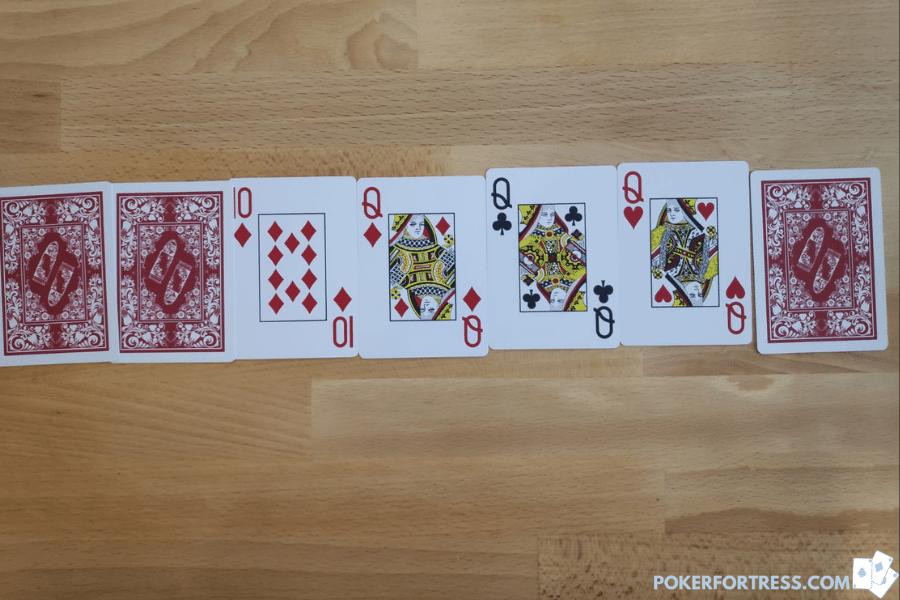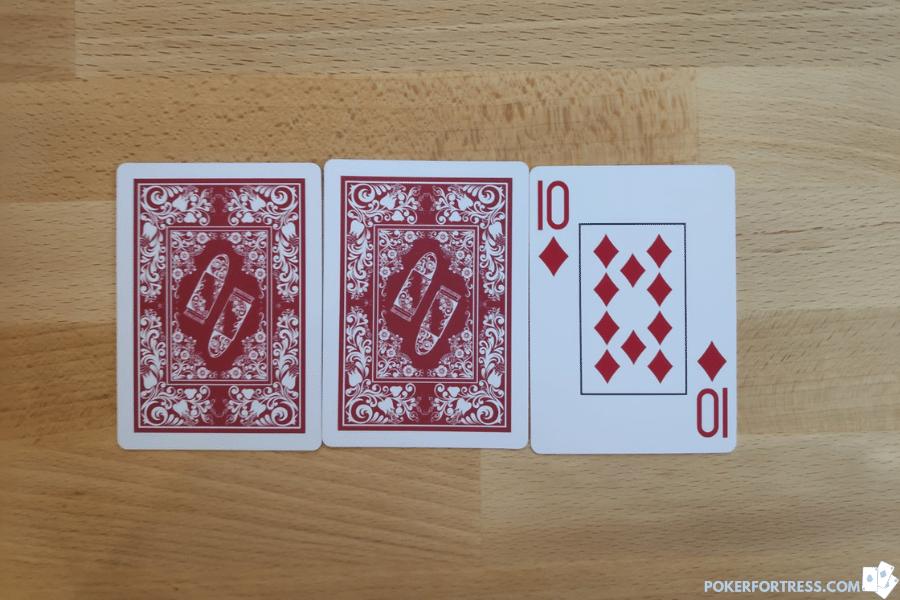7 card stud used to be the most-played variant of poker until it was dethroned by Texas Hold’em. Even though 7 card stud isn’t at the top of poker’s pecking order anymore, there’s still significant interest in the game. In this article, I’ll be providing a comprehensive guide to help people that are new to the game.
The first things you have to learn about 7 card stud are the rules, setup, and skills/strategies required to win. After that, you’ll have to acquire practical experience by playing the game, preferably not live at a casino at first.
Like I said earlier, 7 card stud reigned supreme in the poker world before the start of the Texas hold’em poker boom some years ago. The game can be played by two to eight players (5 card stud can be played by up to ten people) and the most significant difference between 7 card stud and Texas hold’em/ Omaha is that the former does not involve a flop. Also, community cards are rarely involved in 7 card poker.
Texas Hold’em isn’t the only variant of poker that has surpassed 7 card stud in the past decade. Even Omaha has grown a lot in popularity and can be said to be the second most popular variant of poker. However, don’t for any reason think 7 card stud is outdated and no longer important.
7 card stud is played in tourneys, casinos, and even at home by poker enthusiasts.
Want to master 7 card stud? Then the books below are perfect for you:
| Image | Title | Prime | Check Price |
|---|---|---|---|
 Top
Top | High-Low-Split Poker, Seven-Card Stud and Omaha Eight-or-better for Advan (Advance Player) | PrimeEligible | Check on Amazon |
 Top
Top | Seven-Card Stud for Advanced Players | PrimeEligible | Check on Amazon |
You’ll need to have a good knowledge of the rules and strategies of the game to excel at it. But that’s why you are here, right? I’ll dive into it straight away.

Key Skills for 7-Card Stud
You won’t have a hard time with 7 card stud as some of the skills the game requires are similar to that of other variants of poker. Below are skills that will come in handy during the course of the game.
Strict hand selection
The first thing every beginner poker play thinks when playing is whether to call, raise or fold. The truth is that the answer to this question is simple. Yet we make it complicated for ourselves. Hand selection is one of the most important aspects of any variant of poker. Building and using hand selection charts will help you in this regard.
Discipline
Discipline, they say, is a virtue. This saying couldn’t be any truer in poker. You need to be able to wait for a good hand and avoid competing with second rate hands. You should make conscious efforts to work on your patience and discipline.
The truth is that all skills, tactics, and strategies in poker run through discipline. Your poker knowledge, no matter how vast, will quickly become worthless if you aren’t disciplined as you won’t be able to apply what you know.
Ability to read opponents
You don’t have to develop psychic powers to read your opponents. All you need is an experience (which will come in time) and a keen sense of observation. Time to become Sherlock Holmes, my friend. You put yourself in a fantastic position to win if you are able to understand your opponents’ weaknesses. This will allow you to take optimum advantage of those weaknesses and adapt your game to exploit your opponents’ flaws. Also, it’ll be very difficult for your opponents to defend against you.
You can also spot ‘tells’ from players in online poker. Read more about it in How to Tell if Someone is Bluffing in Online Poker?
James Bond in the movie ‘Casino Royale’ is very adept at reading tells. You can check out the movie though, lots of action and poker. Ha, the good old times. It has even made it on our Best Poker Movies of All-Time list.

Ability to remember the other players’ up cards
7 card stud requires a lot of concentration as well as a good memory. In fact, 7 card stud is regarded as the greatest memory poker game. You have to be able to remember all the cards that have been folded during the game if you want to have an edge.
Remembering the cards that have been folded allows you to determine the possibility of the remaining cards in the deck that are yet to be dealt. Also, astute and thoughtful poker players will be able to predict/determine the cards dealt to their opponents. How will they do this? It’s simple. They just combine the cards they’ve seen with the cards that have been folded and they will have a good idea of their opponents’ hands.
People blessed with photographic memory have no problem in this area. But not everyone has a photographic memory. However, there are ways you can improve your card memory. One such way is to first focus on folded cards and trying to remember the ranks and suits of the cards.
7 Card Stud vs. Texas Hold’em
You know that 7 card stud and Texas Hold’em are two different variants of poker. I’ll be talking about the major differences between the two games. While some differences are very obvious, others are not.
One of the main differences between the two games is that ante and a bring-in bet are used in 7 card stud while blinds are used in Texas Hold’em. There are two blinds in Texas Hold’em, mainly the big and small blinds.
Community cards are rarely used in 7 card stud. Also, there are five betting rounds in 7 card poker in contrast to the four bettings rounds in Texas Hold’em. Also, the positional advantage doesn’t exist in 7 card stud prior to the dealing of the cards. It is the cards players receive that will determine who will act first or last during the betting rounds.
A fast summary of the differences between 7Card Stud vs. Texas Hold’em:
- 7 card stud uses bring-in bet and ante, while the Texas Hold’em uses big and small blind
- community cards are rarely used in 7 card stud
- 5 betting rounds in 7 card stud vs. 4 in Texas Hold’em
- positional advantage doesn’t exist in 7 card stud before the dealing of the cards
7 Card Stud – Game Setup
You obviously don’t need to set up anything if you will be playing the game live or online on poker sites. However, if you are going to play the game at home with your friends and family, you have to get some things in place.
The first you have to do is to get enough chips for everyone participating in the game. If you don’t have chips or they are not enough, there is no need to worry. There are several items in your home that you can use as alternatives to poker chips.
You’ll have to decide on the amount of a big bet, small bet, as well as an ante. The size of these bets will determine how large your game will be. Know that the big bet is usually twice the amount/size of the small bet. The ante is usually fixed around 10% of the size of the big bet.
Also, you’ll have to decide on the size of the buy-in. Then a player needs to act as the dealer and shuffle cards. One thing about 7 card stud is that anyone can be the dealer. Being the dealer doesn’t affect the gameplay. Just know how to shuffle and deal cards properly.

Game Play
To begin each hand, everyone at the table will be dealt two cards first. The first two cards will be dealt face down before a third, which will be face-up, is dealt. The third card is usually referred to as the third street.
The first two cards dealt facing down are often referred to as the hole cards. The third card is usually referred to as the door card. You then have the chance to decide if you want to go on with the game or not after seeing these three cards.
In the end, you’ll have seven cards for which you’ll select the best five cards for the showdown.
Rules for Seven Card Stud
Ante
Just like the way Texas Hold’em and Omaha has the blinds as their forced bets, the ante is the forced bet in 7 card stud. Everyone at the tables will have to pay the ante in order to be dealt cards. You’ll be informed of the size of the ante before the game starts. The size of the ante depends on the game you are playing (there are variants of 7 card stud) and where you are playing it.
Let’s assume you want to join a $10/$20 7 card stud table that has an ante of $1 and a bring-in bet of $5. Everyone at the table will have to pay the $1 ante bet to be dealt cards. The ante means there’s already a pot worth competing for by the time the cards are dealt.
It’s also been noticed that players fold less often in games that have an ante. After all, they’ve already contributed to the pot and won’t get the ante back if they fold. So they feel they might as well wait for a betting round or two.
Third Street
As explained under the gameplay above, everyone is dealt three cards initially, two face down (hole cards) and one face up. So there is now the issue of who to start the action after the cards have been dealt. Well, the rules of the game have this covered. The player with the lowest ranking exposed card (door card) will start the action by playing the ‘bring-in bet’. This player is also referred to as the ‘bring-in’.
The bring-in has the option to either pay the bring-in bet or the small betting limit of the game. Using the example of the $10/$20 7 card stud with a bring-in of $5 above, the bring-in player will have to pay the bring-in bet ($5) or the small betting limit ($10).
Either way, the bring-in kickstarts the action. After that, betting will continue in a clockwise direction and the betting round ends when everyone at the table has taken an action.

Fourth Street
After all betting activities in the third street have been concluded, the players will be dealt another exposed card, which is usually referred to as the ‘Fourth Street’. This time, the rule that decides who acts first is different from that of the third street.
The first player to start the action in the fourth street is the individual whose door cards (exposed cards) have the highest ranking. For instance, a player with an exposed pair of Kings will have to act first and kickstart the action in the fourth street if no other person on the table has better cards, say a pair of Aces.
This player has the option to check (pass the action to the next player on his left) or bet the lower structured betting amount. The betting round ends when everyone at the table has taken an action.
Fifth Street
Here, the players will be dealt another card face up. This new exposed card is usually referred to as the ‘Fifth Street‘. Like in the fourth street, the first player to act will be the person whose door cards have the highest rankings. This player can then bet or check.
The remaining players on the table will also take action.
Starting from the fifth street, players are mandated to bet the higher betting structured amount.
Sixth Street
Another card is dealt to all players face up. This card is called sixth street. The card with the highest-ranking exposed cards will start action here having the option to bet or check. Then another round of betting takes place.
Seventh Street (or the River)
Here, the last and seventh card is dealt to all the players. The last card is received face down and only known to the individual players. The player with the highest-ranking exposed cards takes action first. Then, the other players take action in the final betting round. If at the end of the betting round there is still more than one player at the table, the showdown will take place.
The Showdown
The purpose of the showdown is to determine the winner when more than one player remains at the table after the final betting round. The last person to bet or raise will show his/her cards first. If no bet occurs in the last betting round, then the player in the earliest seat shows his or her cards first. There’s a way casinos number seats, so the player in seat starts first, then seat 2, and so on.
Showdowns are exposed clockwise around the table. Players can use any five of their seven cards to form a hand and the player with the best hand wins. In a situation where two players have hands of the same ranking, the pot will be shared equally between the two players.
After the winner has received the payout, a new game is ready to be played.
Additional Stud Rules and Situations
Ties occur sometimes when the player to pay the bring-in bet is being determined. Remember that the player with the lowest ranking card will pay the bring-in bet in 7 card poker.
When ties occur when determining the bring-in player, they are broken by using suits. The ranking of suits is done using alphabetical order. This means clubs will be the lowest suits. Diamonds will rank higher than clubs and hearts will rank higher than diamonds. This means spades are the highest ranking suits.
The lowest suit will break a tie as the player with the lowest ranking hand will be the bring-in. So in a situation where you have a deuce clubs hearts and a deuce of clubs as door cards at the beginning of a hand, the player with the deuce of clubs (the lower ranking suit) will be the bring-in. I must mention that this rule doesn’t apply to equal hands at showdown.
In a situation where a player with the lowest ranking exposed card on Third Street goes all-in for the ante and is then unable to place the bring-in bet, another player will have to make the bring-in bet. The next individual on the left of the player unable to place the bring-in bet will become the bring-in. In this scenario, the rankings of the next player don’t matter. As long as he/she is on the immediate right of the player unable to pay the bring-in, he/she will have to do so.
The big bet typically starts in the fifth street. However, there’s a scenario where big bets can be placed in the fourth street and this is when any player shows a pair. This allows the betting to either be opened or raised to the size of one big bet. Should anyone make a big bet at this stage, then big bets will have to be placed for the remainder of all betting actions In the fourth street.
There are situations where cards run out in 7 card stud bringing about the use of a community card. This will be explained better below.
7 card stud strategy
Like with any other variant of poker, you need to have a strategy for 7 card poker. I must mention that the concepts and rules discussed in this article should be seen as general guidelines only. There may be exceptions to the rules and strategy in this article depending on the variant of 7 card stud you are playing and where you are playing it.
A truly successful poker player is one that understands he/she must be able to make exceptions. Also, you have to believe in your judgment as you try to come up with your best possible play. Why am I saying all this? It’s because it’s not possible for me to give you advice that applies to all situations.
Enough of the monologue. The best general strategy you can use is summarized by Mike McD below;
“You only play premium hands. You only start with jacks or better split, nines or better wired, three high cards to a flush. If it’s good enough to call, you got to be in there raising, all right?” – Mike McD from Rounders.
Always play live cards and these are cards that have the potential to improve. Let’s assume you are starting the game with a three flush – three cards of the same suit. Then, you find out that other cards belonging to this suit are also onboard. Your hand here can’t improve much and you’ll do well to discard your cards.
Also, big pairs are strong hands when playing against a few opponents while drawing hands do much better in tournaments. And having one or more high cards adds more value to your hand. The more the high cards, the better.
What if there are not enough cards in the deck?
Remember that a maximum of 8 players can play 7 card stud. When a 7 card stud table is full, then the card will not be enough. The standard 52-card deck is used for 7 card poker with each player receiving seven cards.
When the table is full (consisting of eight players), that means 8 x 7 cards will be needed. That’s 56 cards. But the thing is that the cards are usually always enough in 7 card stud even when eight players are playing at the tables. This is because it’s unlikely all the players at the table will make it to the showdown.
But what will happen if every single player (when eight players are competing) sitting at the table makes it to the showdown. This means there won’t be enough cards to deal to the players. Luckily, there’s a rule that governs how things proceed in this scenario.
In situations where there are not enough cards remaining in the deck for all players, then all the remaining cards will be dealt with the exception of the last card. The last card will then be mixed with the burn cards. The burn card is the first playing card dealt from the top of a deck or a pile of such cards. Burn cards are never shown to players.
After mixing the last card with the burn cards, the entire pile is then shuffled, cut, burned and the remaining down cards dealt to the players. In a scenario where there are not as many cards as players remaining without a card, there is no need for the dealer to burn cards. And this will ensure that everyone at the table is dealt a fresh card.
However, if the dealer finds out that there won’t be sufficient fresh cards for all the remaining players at the table, then the dealer will use a community card. The dealer must first announce his/her intention to use a community card to the table. A card will be burned and placed face up in the center of the table. The community card will be part of the hands of all players at the tables.
Any player who has the highest-ranking cards putting the community card into consideration will take the first action for the last round. Using a community card saves cards as a single card will be shared by all players instead of dealing out eight cards in a scenario where the table is full.
Common Mistakes in 7 Card Stud
There are some common mistakes that players make in 7 card stud. I’ll be talking about these mistakes and you’ll be able to learn from them and become a better 7 card stud, and poker in general, player.
- Playing too many starting hands – This is a problem many poker players suffer from. Using the starting hand selection charts will help you. The charts are used by many poker players as they inform you about what hands to play from each position at the table.
I’ll advise beginner poker players to print these charts and get familiar with them. You can even post them on the walls of your room so you see them regularly and memorize them if it helps you. You won’t have to use the charts as you gain more experience as you’d have memorized it. - Not paying attention to which cards are out – Recall that you need to keep track of the cards that are being folded during the game. I talked about how doing this can give you an edge in 7 card stud.
- Not folding with modest holdings and weak draws – Folding in poker is an art and one you’ll become better at as you gain more experience in the game. Knowing the right time to fold is very important and you should fold when you have weak draws.
- Not raising with premium holdings– If you don’t raise when you have strong cards, you let too many drawing hands in. For instance, imagine a scenario where you called an opponent that raised showing three to a flush with a straight draw. Doing this will most likely land you with a losing, second-best hand.
There are charts (starting hand charts) that tell you when to raise, call, and fold. Just like folding, raising is a special aspect of the game you’ll master over time. - Paying exclusive attention to your own game – Poker isn’t a game where you mind your business. You have to pay attention to the game of your opponents. You need to keep track of happenings on the table as the number of players remaining in the game on the fourth street or the player(s) that raised on the third street.
Read your opponents and see if you can find any tells. You need to know the type of players you are up against. It’s important you know when to be aggressive, particularly on the third street.



